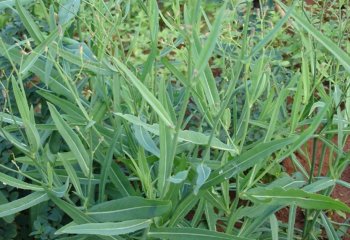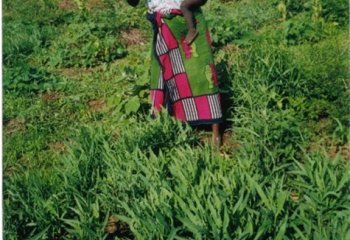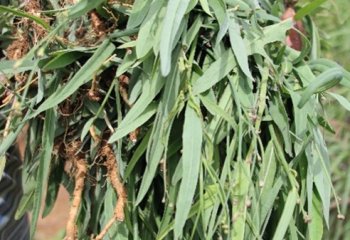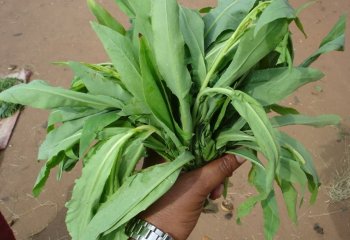Geographical Distribution in Africa
Launaea cornuta is native to Africa. It is commonest in the East African countries, particularly the coastal region from Somali to Mozambique.
Introduction
Launaea cornuta, commonly known as bitter lettuce or mchunga, is an erect perennial plant with up to 1.5 m tall hollow stems and creeping rhizomes. L. cornuta is a member of the Asteraceae (Compositae) family, one of the eight families comprising the order Campanulales. The plant is native to Africa and occurs on alluvial soils in cultivated areas, including irrigated crops, on roadsides, near rivers, and bush vegetation. A single plant can cover a large area because of the spread of rhizomes. Its range extends from Nigeria to Djibouti and Somalia to Zimbabwe and Mozambique in the south. In East Africa, it is predominantly used as a wild vegetable, as feed for rabbits and lambs, and to boost milk yield in cows. It is rich in nutrients, such as proteins, fats, carbs, calcium, phosphorus, iron, and ascorbic acid. The plant has several ceremonial uses among the Mijikenda in Kenya. It is utilized for its anticancer, antidiabetic, insecticidal, antimalarial, antibacterial, and anthelmintic properties. It has been used to treat gonorrhea, syphilis, sore throats, coughs, typhus, nasal-pharyngeal infections, measles, swollen testicles, spleen pain, earaches, hookworm eradication, and fever L. cornuta is vegetatively propagated locally through rhizomes.
The leaves are collected primarily from the wild. Nonetheless, there is some cultivation in Ethiopia, Somalia, Kenya, and Tanzania, primarily in home gardens. Recently, production in a peri-urban setting for urban markets has emerged. This vegetable is commonly found in the coastal regions of Kenya, Tanzania, and the Usambara Mountains, as well as in local markets. However, no cross-border trade exists.
(Schippers, R.R., 2004, Hiene and Heine, 1988, Kinyanjui G et al., 2015, Abukutsa, 2007, Burkill, 1985, Ndossi and Sreeramulu, 1991, Ambajo & Matheka, 2016.
© Adeka et al., 2005. Foods of the Nairobi People. A picture book of foods found in Nairobi Markets
Species account
Launea cornuta is a small much-branched shrub usually 1.0-1.5 m high, occasionally to 3 m. Stems ridged. Leaves: Grey-green, long, narrow lobed laterally, often on one side and with a toothed margin, Aromatic. Flowers: Purplish pink, borne in clusters, Corolla over 3 mm across at apex. Fruits: Small (2-3 mm) green, shiny, turning reddish purple when ripe, numerous on one head, each one-seeded (Maundu et al., 1999).
© Maundu, 2000
© Muia J, 2023
Ecological information
Launaea cornuta grows in disturbed localities such as roadsides or as a troublesome weed in perennial plantations of trees or shrubs. It can also be found in grassland. It is most common in the hot lowland coastal zones of East Africa and near the great lakes and less common in highland areas up to 2300 m altitude. It prefers sandy soils in relatively dry localities but grows on loam and black cotton soils (Schippers, R.R., 2004).
Agronomic aspects
Planting
The vegetable is normally not planted as it is a common weed where it is used as a vegetable (Maundu, P.M.et al., 1999a). Bitter lettuce can be propagated vegetatively. People may select plants from the wild that are sweet or only slightly bitter and plant these in their gardens. Some gardeners split the roots from carefully selected plants to produce several new plantlets and thus create a uniform crop of the desired type (Schippers, R.R., 2004).
© Maundu, 2015
Management
Care should be taken to prevent bitter lettuce from spreading as a weed (Schippers, R.R., 2004).
Harvest, post-harvest practices and markets
Harvesting
Harvesting is done by uprooting the entire plant when it reaches maturity but before flowering. Alternatively, leaves can be selectively picked. It's worth noting that individuals prefer sizable rosette leaves due to the excessive bitterness of older and smaller stem leaves. (Schippers, R.R., 2004).
Markets
Although predominantly gathered from the wild, there is a noticeable increase in cultivation across Ethiopia, Somalia, Kenya, and Tanzania. This versatile vegetable has gained popularity in local markets along the coast and in the scenic Usambara Mountains. Moreover, there is a rising trend of production in peri-urban areas to cater to urban markets. However, it is important to note that cross-border trade of Launea cornuta is still limited at present (Schippers, R.R., 2004).
© Maundu, 2006
Ⓒ Maundu, 2006
Nutritional value and recipes
Launea cornuta leaves are known to have a pronounced bitterness, which is why they are often used in combination with other vegetables to balance out the flavor. In the coastal region of Kenya, particularly among the Mijikenda community, bitter leaf is commonly mixed with less bitter vegetables such as Asystasia gangetica, amaranth, pumpkin leaves, cowpea leaves, and Vernonia cinere. The cultural practice of draining water when cooking bitter lettuce is prevalent, particularly among the Mijikenda community in coastal Kenya. This technique is employed to mitigate the inherent bitterness of the lettuce. There is a need for comprehensive research to ascertain the nutritional profile and implications of such practices on the nutrient content of bitter lettuce
Table 1:Proximate nutritional composition of 100 g of Launaea cornuta leaves
|
Young Launae cornuta leaves |
Recommended daily allowance (approx.) for adultsa |
|
|
Water (g) |
86.8 |
2000-3000c |
|
Protein (g) |
3.9 |
50 |
|
Fat (g) |
0.9 |
<30 (male), <20 (female)b |
|
Carbohydrates (g) |
4.5 |
225 -325g |
|
Calcium (mg) |
214 |
800 |
|
Phosphorus (mg) |
13.2 |
800 |
|
Iron (mg) |
7.2 |
14 |
|
Vit C (mg) |
18.7 |
60 |
Source (Nutrient data): Chemical studies on the nutritional value of Launaea cornuta (Ndossi, G.D. & Sreeramulu, N., 1991)
$ Draining the water several times leaches away water soluble nutrients significantly.
a Lewis, J. 2019. Codex nutrient reference values. Rome. FAO and WHO
b NHS (refers to saturated fat)
c https://www.hsph.harvard.edu/nutritionsource/water/
d British Heart Foundation
e FDA
f NIH
g Mayo Clinic
It's important to note that these values are approximate and can vary depending on factors such as the specific variety of the leaves and the growing conditions. It is always advisable to consult a healthcare professional or nutritionist for personalized dietary recommendations.
Complimentary recipes
a. Muthunga. (Mbeere recipe) *
*Ingredients*
• 100 g Bitter lettuce leaves
• 50 g of Amaranth
• 60 g onions
• 40 g tomatoes
• 3 tablespoons cooking oil
• Salt to taste
• 1 cup of water
*Preparation*
• Sort the bitter lettuce leaves, wash and chop finely (they can also be cooked whole)
• Bring the vegetable to a boil twice for five minutes, pouring the water from the vegetables each time.
• Clean, wash and chop the onions
• Fry the onions with salt lightly.
• Add chopped amaranth leaves and stir well; cover the pan for 1 minute and simmer
• Add the boiled Bitter lettuce to the cooking amaranth cover the pan for 1 minute and simmer
• Season to taste and serve hot with stiff porridge (Preferably made from sorghum and Millet).
*Variations*
• Use pumpkin leaves' instead of Amaranth
• Groundnut flour/peanut butter can be added to the cooking vegetable to flavor.
*Yields*; 6 servings
Remarks
Muthunga leaves are mixed with other vegetables like Cowpea, amaranth, and Corchorus to mask the bitterness. The vegetable meal is appreciated by the elderly in the community.
The Mutsunga are believed to remedy stomach discomfort.
*Source*: Ms. Yvonne Mumbi, secretary Kagirimu African culture preservers
b. Fried Mchunga
Ingredients
• 100 g mchunga
• 40 g (1 medium) onion
• 3 tablespoonfuls butter/margarine
• 60 g (1 medium) tomato
• 2 cups water
• ¼ cup fresh cream
• Salt to taste
Ingredients
• Preparation
• Remove the vegetables from the stalks and clean them
• Boil the water and add salt to taste
• Blanch the vegetables for about 2 minutes
• Drain the hot water and run cold water through the vegetables
• Heat a pan, melt the butter and fry the chopped onion not letting it brown
• Add the vegetables and cook them for 2 minutes, stirring them constantly
• Add the chopped tomatoes, stir
• Add the fresh cream, salt to taste and seasoning of your choice and stir
Serve with accompaniment of your choice
Yields five servings
Remarks
Mchunga is a quite bitter vegetable but adding cream or butter tones down the bitterness. Blanching helps to preserve the green colour.
Information on pests and diseases.
No record of plant pests and diseases.
Contacts
No contacts are available but root stocks can be sourced from farmers with the crops.
Reference list and information links
- Abukutsa MO (2007). The Diversity of cultivated African leafy vegetables in three communities in western Kenya. Afr. J. Food Agric. Nutr. Dev. 7(3):1-15. Burkill HM (1985). The useful plants of West Tropical Africa. 2ndEdition. Volume 1, Families A– D. Royal Botanic Gardens, Kew, 1.
- Agnew, A.D.Q. & Agnew, S., 1994. Upland Kenya wild flowers: a flora of the ferns and herbaceous flowering plants of upland Kenya. 2nd Edition. East Africa Natural History Society, Nairobi, Kenya. 374 pp.
- Ambajo, F. & Matheka, J.M. (2016). Micropropagation of Launaea cornuta-an important indigenous vegetable and medicinal plant. African Journal of Biotechnology, 15(32), 1726-1730.
- Burkill, H.M., 1985. The useful plants of West Tropical Africa. 2nd Edition. Volume 1, Families A–D. Royal Botanic Gardens, Kew, Richmond, United Kingdom. 960 pp.
- Kilian, N., 1997. Revision of Launaea Cass. (Compositae, Lactuceae, Sonchinae). Englera 17: 1–478.
- Kinyanjui, G., Misonge, J.J., Kingori, W.S., & Mwalukumbi, J.M. (2015). Phytochemical screening and cytotoxicity evaluation of Launaea Cornuta H. (Asteraceae) using brine shrimp.
- Leung, W.-T.W., Busson, F. & Jardin, C., 1968. Food composition table for use in Africa. FAO, Rome, Italy. 306 pp.
- Maundu P.M et al 1999b. "Kenya". The Biodiversity of Traditional leafy vegetables edited by; Chweya, J.A.; Eyzaguirre, P.B. (eds.) (1999) International Plant Genetic Resources Institute (IPGRI), Rome, 15-45.
- Maundu, P.M., Ngugi, G.W. & Kabuye, C.H.S., 1999a. Traditional food plants of Kenya. Kenya Resource Centre for Indigenous Knowledge (KENRIK), Nairobi, Kenya. 270 pp.
- Schippers, R.R., 2002. African indigenous vegetables, an overview of the cultivated species 2002. Revised Edition on CD-ROM. National Resources International Limited, Aylesford, United Kingdom.
- Ndossi, G.D. & Sreeramulu, N., 1991. Chemical studies on the nutritional value of Launaea cornuta - a wild leafy vegetable. Journal of Food Science and Technology 28(3): 183–184
- Schippers, R.R., 2004. Launaea cornuta (Hochst. ex Oliv. & Hiern) C.Jeffrey. [Internet] Record from PROTA4U. Grubben, G.J.H. & Denton, O.A. (Editors). PROTA (Plant Resources of Tropical Africa / Ressources végétales de l’Afrique tropicale), Wageningen, Netherlands. <http://www.prota4u.org/search.asp>.. Accessed 1 January 2023.
- The International Plant Names Index and World Checklist of Vascular Plants 2022. Published on the Internet at http://www.ipni.org and https://powo.science.kew.org/
Other references
- Royal Botanic Gardens Kew, 2023. Launaea cornuta (Hochst. ex Oliv. & Hiern) C.Jeffrey. https://powo.science.kew.org/taxon/urn:lsid:ipni.org:names:229002-1. Accessed 1st January 2023.
Review Process
Dr. Patrick Maundu, James Kioko, Charei Munene and Monique Hunziker, January 2024






